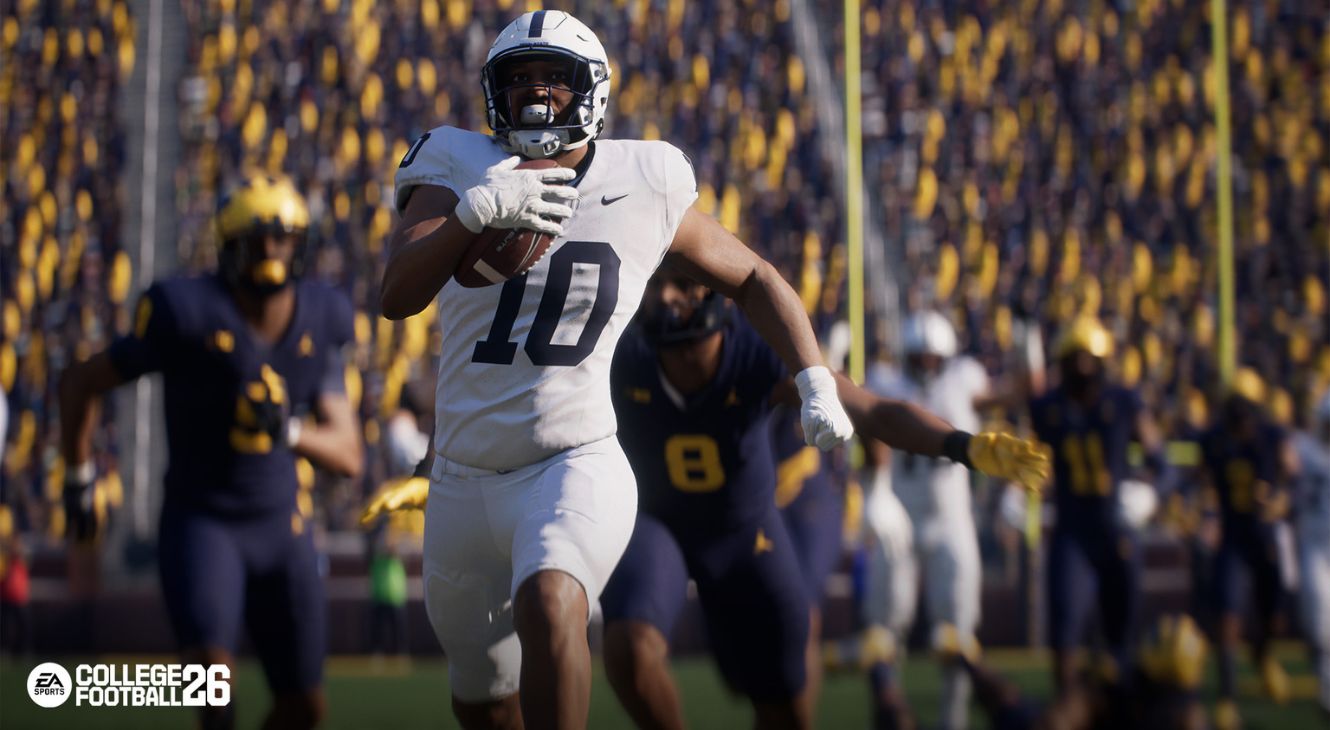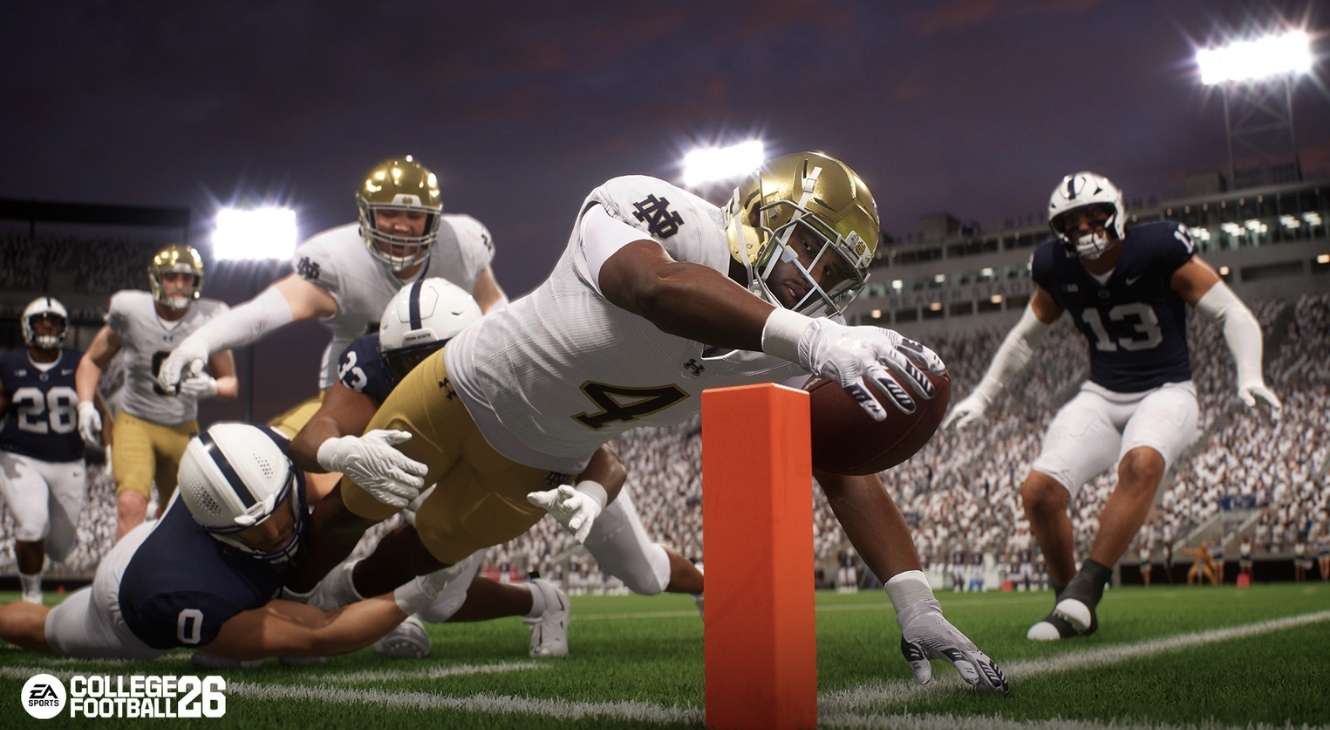Want to listen instead? Listen to our EA Sports College Football 26 Dynasty Deep Dive with Ben Haumiller here.
EA Sports revived a community with EA Sports College Football 25 last year. Now, the development team is growing that community by expanding their investment in the quality of life elements that make Dynasty the leading mode of their game in EA Sports College Football 26 (CFB 26). During the media preview event, we spoke with Ben Haumiller, CFB 26’s Principal Game Designer, who has been with EA for 25 years.
The first thing to note is that Ben Haumiller loves college football. More importantly, the NCAA series of games is what made him want to be a developer to begin with. Now, 25 years later, he shared his story on how he began working on EA’s top-selling sports game.
“I started in QA,” Haumiller said, “Then I became a designer, [then a] producer, left development for a while and was in business affairs, working on partnerships and licensing, because this game went away. [NCAA] is the game that brought me into the industry. [NCAA] is why I’ve always wanted to be a game maker. I never knew working on [a sports video game] was an option.”
He continued, “But I grew up here in Orlando, and I found out that they made the game here. I was at Florida State, and [EA] used to do a tournament to determine the best player in the country. And I just happened to talk to one of the guys, and he said, ‘We’re always looking for game testers.’ And so, [being a developer] started as a summer job, but then I never left. I’ve always had a desire to work on college football.”

As a community, we had waited almost a decade for EA Sports to resurrect its college football game. And Haumiller was waiting even longer. “NCAA 05 was the first one I could work on, and then obviously, 14 was the last. Development went dormant for 11 years. I was patiently waiting to figure out the time for this thing to come back, and I knew I had to be here to bring it back.”
Haumiller’s story is one of passion that centers on the love of the sport. “I left development [for Business Affairs] because I wanted to learn that side of the business. I also knew when we got back into [college football] that vertical was the tip of the spear—the licensing side, to figure out the agreements. So I started working on that portion of it.”
At this point, Ben Haumiller is still introducing himself, and I didn’t want to stop him. As a player myself, hearing a developer share his passion for a franchise is a peek behind the curtain. It helped set the foundation for our conversation and showed how much care was put into College Football 26. Haumiller continued, “I had to come back [to development] and help build this team and build it the right way. Now that is very important to me, the unfinished business of making sure that this game came back, because it meant so much to me, and I also saw how much it meant to other people.”
“I was at Florida State, and [EA] used to do a tournament to determine the best player in the country. And I just happened to talk to one of the guys, and he said, ‘We’re always looking for game testers.’ And so [being a developer] started as a summer job, but then I never left. I’ve always had a desire to work on college football.”

Talking with Ben Haumiller, it was clear that College Football 26 and its larger franchise aren’t made in a silo. They’re developed with player feedback in mind, crafted for the community playing the game. And in CFB 25, there were plenty of feedback points to incorporate into CFB 26, especially where Dynasty is concerned. But how does balancing player feedback against necessary development choices work? How does Haumiller lead his team to be considerate but not hyper-reactive?
Haumiller explained, “I think what I love about [developing College Football] is that it’s kind of concentric circles, right? The business goal and the fan are almost a flat circle. There are definitely things that hit on either end. But, man, there were so many things that we wanted to do that.
We felt as a business that what we needed to do for this game was to make [CFB 26] a better game overall, and to build on things that we did the first year that we might not have gotten where we wanted them to or new experiences to add in that we wanted to have. Still, you also just have to listen to the fans and everything they were saying.”
And for Dynasty, where the bulk of the changes to College Football 26 have been made, it was clear that the team listened. Ben Haumiller even pointed out that many players on-site at the media event noted, “I had a list of 10 things I wanted in Dynasty, and you hit them all.” That kind of success is hard to achieve, especially in annual sports games. And for Haumiller, that feedback made him happy: “That [feedback] makes you feel so good to know that what we wanted to do lines up so well with what our fans want.”
Players and passion are driving College Football 26 forward, and Ben Haumiller made that clear. “The most important metric that this game has is engagement. How do fans feel about the game? We don’t care about anything else. We care about how fans feel about the game and how much they play it. So when you see guys, they’re playing 1000 hours, or you see people who are going 30 years in a dynasty, they’re playing deeper and longer in this game than most other sports games, it makes you say, ‘We’ve got something here. We got lightning in a bottle.'”
EA Sports College Football 26 team had to try and capture lightning in a bottle once again.

But whether or not EA Sports captures that lightning in a bottle again after the series launch with CFB 26 stays top of mind for Haumiller, especially given the development time for yearly titles. “You have a limited amount of time to make a new game,” Haumiller explained.
Continuing, “So what are the things that will resonate most with your fan base? You make sure you hit as much of [what they tell you they want] as you can. But also, it’s the quality of life stuff that they might not even realize.” While large changes to gameplay, like moving to fully physics-based play, are important, Haumiller is right in identifying that the quality of life elements are what keep the game fresh and that players are invested in year 30 of a Dynasty and beyond.
Discussing those QOL updates active in College Football 26, Ben Haumiller started to talk about recruiting. “When you’re in recruiting, you used to have to pop open team needs separately, it’s a big thing to not be able to see all that. Now, [Team Needs are] just right there as a little module at the top of recruiting. You can always see it, and it just makes your day-to-day so much easier. You don’t have to close things out and go into another menu just to see something, just to back out, and then go back and try to remember that information. We’re just trying to make that stuff so much easier for [players].”

He continued, “And I think our fans respect and love that, because it’s not big and bad EA, behind this curtain that just shoves out every game. We’re out there talking to folks. I mean, we are the players who are just as hardcore as those hardcore players. So it kind of works out well to have that kind of a team and that mindset that, you know, [College Football] the fans’ game, it’s not anybody else’s.”
Haumiller’s excitement to talk about College Football was infectious, and of course, wearing my alma mater’s shirt to the preview event kept the conversation naturally going, more specifically, on how EA Sports approaches school authenticity with 136 schools represented. Haumiller pointed out my shirt, “I mean, Texas State, right? We shipped last year, and we’re missing something crucial to Texas State. And so we came back out and we rectified that. We were able to do that in [CFB 26], and that’s one of the things we appreciate very much.”
“I think about my time here, 25 years, and when I started, there were no patches. We would have to say, ‘We screwed that up. Sorry. We’ll fix it next year.’ And now look at the things that we can turn around and do quickly. So it’s amazing to see all that stuff come on along the way, too,” Haumiller ended.
CFB 26 Dynasty Mode is all about longevity and quality of life: Dealbreakers and Manual Player Progression is the foundation.

Moving on from authenticity and the generalities around College Football 26, we shifted our conversation toward key Dynasty components. One of which, players had been waiting to be bolstered: Dealbreakers. In CFB 26, Dealbreakers have become more dynamic and will push volatility to replicate the ways that students transfer in the world of college football. Haumiller explained, “So the Dealbreaker piece is very important to us, as far as being that linchpin for a lot of what decisions happen for a recruit, right? Last year, everybody had the same thing they were looking for out of a grade.”
Haumiller continued, “Now, it’s dynamic because some players are looking for a lower grade. So you might be able to get a player who cares about playing time, but he only wants the grade to be a D. He doesn’t need it to be a C, or A, or B or anything like that, but those elite players, they do need to be higher. So you have that part of it, and that’s going to help you be able to go after more players.
“Potentially, that can change throughout the course of his career. He might start only wanting a playing time of D, but he might change that over time to now be a C or [higher]. That will cause you to potentially lose that player to the portal if you cannot convince them to stay,” he said.

“A lot of those decisions that we’re making with those sorts of things that the dynamic Dealbreakers are really for [Transfer] Portal usage to get more players into the Portal. That was one thing we saw. You started out pretty hot with a lot of players in the Portal, and then over time, it got smaller and smaller and smaller. We needed to hit a consistent number. And so, Dealbreakers [became] the driving force of what puts a player in the portal. We had to put them on everybody to increase the number of people who can go right in,” Haumiller said.
The depth that Dealbreakers bring to College Football 26 can’t be understated, and a lot of that comes down to the fact that the game can be played as the player chooses. Haumiller explained, “I love that there is no one way to play this game, right? There’s no one way you’re not gonna recruit at Texas State and recruit at Texas, because you have different abilities.”
“It was really important for us to build that out and to have those dynamic Dealbreakers, both like the ones that are generated, [and] the ones that can change over time. The dev traits can also change, which can make a player progress faster than he previously thought. You want to stick with those two-star kids, maybe, if you’re a smaller school, because they can grow into, you know, elite players,” Haumiller continued.
The real sport of college football is volatile, and so is the Transfer Portal; the CFB 26 team is trying to capture that.
Haumiller also explained that whether you’re looking to differentiate school styles or trying to get a larger pool of talent for the Transfer Portal, it all comes down to dynamic Dealbreakers. One of the Dealbreakers that runs across every recruit is Playing Time. It’s here that the development team looked to build a more realistic representation of college football as well.
Ben Haumiller added context, “Last year, playing time was a specific Dealbreaker; either they had it or they didn’t. And so, if you happen to be fortunate enough to have a guy who was an elite player, and conference prestige was the Dealbreaker, [you could] basically stash him a little bit, and he’s not going to be looking to go as often. And that just doesn’t match with modern College Football. You’re not able to just stockpile talent like he used to. Those guys are looking to go elsewhere [for playing time].”
In addition to being crucial to Dealbreakers, playing time is affected by the depth charts. There were so many exploits you can do of manipulating the depth chart, to say, ‘Well, you’re the starter now,’ ‘Oh, you’re happy even,’ but like, the OVR is the OVR, right? And that kid knows that the other player is better than he is. So that we had that piece, and that’s still there, but now we added that when it comes to playing time, all blue chip players, and specifically quarterbacks, even non-blue chip quarterbacks, they care about playing time.”
“Even if it’s not their dealbreaker, they still will care. And we’re using an addition of counting snaps as a way of telling you that you are actually using this guy [instead of hoarding talent]. He’s not just a placebo, top of that trade. You actually are using him. You’re using him in formation stuff, you’re using them in all these different ways to get him on the field. And you’re satisfying his need to play, even if it’s not a Dealbreaker. If you’re not, then he’s gonna have a chance to go into the portal,” Haumiller said, adding, “[Playing Time] is kind of another way of adding more life to that Transfer Portal.”
With Dealbreakers shifting how you approach Playing Time and the Transfer Portal, the other big change coming to EA Sports College Football 26 is the addition of manually progressing your players. Ben Haumller explained that last year’s choice of auto-progressing players was because, well, “it’s the way we always did it.” However, after listening to the community, it was clear that players wanted more granular control of their Dynasty.
“…We’re not lying when we say [CFB 26] is your game. You guys are telling us what you want, and we’re trying our best to fulfill those things.”

“When we started last year, one of the big mantras was familiar but fresh,” Haumiller said. “We wanted people to come [into CFB 25] and understand it like it’s an old friend coming home, like a dinosaur coming back. But we also needed to modernize things, so we went that route. This time, we said, ‘Let’s just go ahead and do it this way again.’ But then, [we listened to] fan feedback. There are a large amount of fans [who] want to have that additional manipulation of progressing their players. But 85 players are a lot, so maybe you don’t want to do them all.”
He continued, “You can choose to do the ones you want to and then just have them auto-progress the rest. We opened up that piece where you can go in now to every player, if they’ve got skill points to be able to spend, and you can spend them on ratings or the physical abilities to upgrade those. There are new unlock requirements for those as well, which makes it a little harder for them to get those more elite abilities. But with that, you have to balance how much XP they get and your rewards that provide those you have, your dynamic depth trait that gives you more of them.”
The key to College Football 26 is easily seen as player agency, and ultimately allowing the players to have the control they have wanted. And with that comes paying attention to fans who want to min-max everything. Haumiller added, “We also know that users can min-max the game very well to figure out those [nooks and] crannies and get an edge on the AI, but they might not use it the same way. Off the top, there is a 25% tax that if you’re doing manual recruiting. This means that you’re going to get 25% less XP than you would if it were auto-progressing.”

While the EA Sports team has added in an XP cost-sink, they’ve also made sure that players can control that tax in their own Dynasty. He finished, “[The tax percentage is] also a slider that you can change, so you can actually increase that penalty if you want to, or you can get rid of it all the way if you want to.”
“That will give you a chance to go in and have that experience of being able to progress your players, or just not. So you have a lot of options there. It’s like giving people options to play the game they want to. Because, again, we’re not lying when we say this is your game. You guys are telling us what you want, and we’re trying our best to fulfill those things,” Haumiller added.
Player agency is key in CFB 26‘s Dynasty mode, but while we can see the longevity being built, we had to ask Ben Haumiller what he knew he had to get right when it comes to keeping people playing into Year 30 again. “It’s so funny when you think about this game of the rosters, right?” Haumiller started, “25% of your roster turns over every year, just by the fact that 25% of players graduate. More than that, turnover because of the Transfer Portal, and how many guys leave that way. So you can’t really pin your hopes on just one man…”
Haumiller continued, “So it’s your coach’s career that is the thing that I think is the biggest part for you, because that’s you the entire time. It’s how we develop that progression path for the coaches, to build up their skill trees, to try to make those feel unique and feel special, and not always go so wide. We try to build up into those deeper trees.”
“That really helps make it feel like a different experience, and feel fresh, because you’re earning these different abilities each day as you move on. And now that progression cap goes to 100 instead of level 50, it gives you a longer reason to keep playing, to keep progressing your coach, to try out what you know, coaching carousel to go to those different schools, and with those new coaches, the real nil coaches coming in.”
EA Sports College Football tells a story no other sports game can with Dynasty Mode.

Adding real coaches, both head coaches and coordinators, adds a whole new wrinkle to this game that we have never had before, in that when you see coaches moving in the carousel, you’re like, ‘Oh, wow. USF Coach Alex Golesh is the Penn State head coach in 2033!? He won a national championship!?” These are things that extend the immersion into [Dynasty] mode.”
With all of these moving pieces, Ben Haumiller comes back to the core of College Football 26: player choice. “[Dynasty] was kind of like giving players those options to play it their way, too, and not just say you have to play the specific way, because we tell a story that no other sports game tells. You can start as a defense coordinator at Texas State and end up the head coach at Texas, and that’s a career journey that no sports game tells.”
“I think that’s why we saw players get to 30 years so often and way more deep in those modes than others,” Haumiller continued, “Because when you play [other sports games], what’s the incentive once you’ve won a Super Bowl? Or the Larry Bryan trophy in the NBA? What’s the incentive next?”
With a laugh, Haumiller added, “For us, it’s just like, Well, where do I go? I started at UTEP, where do I go next? And every time is different, and not every job will be available to you. So those sorts of things we found, we learned that our fans want to challenge. We’re diving into that a lot more [in CFB 26], and we’re not afraid to make things hard, which I think is so refreshing.”
To close out our interview with Ben Haumiller, we had to bring up authenticity when it comes to Bowl games. The Poptart Bowl is present, and the newly restructured playoffs are taking into account rivalries. But what about mascots? Or let’s say a certain mascot who was banned from the Georgia Dome. I asked Haumiller if Bevo would be allowed in Georgia, to which Haumiller responded with a laugh and said, “As long as Uga isn’t around.” He added that EA Sports College Football 26 won’t have mascots in the Bowl Games beyond those tied to the Bowl.
In the end, Ben Haumiller just loves college football as a sport. It’s why he’s a developer, and ultimately, all of that passion has been put into EA Sports College Football 26’s Dynasty Mode. Ultimately, this is a game for the fans, to keep them playing, keep them building, and ultimately letting them tell their story.
EA Sports College Football 26 releases July 10, 2025, on Xbox Series X|S and PlayStation 5. For more about Dynasty in the Campus Huddle, click here.








![[EXCLUSIVE] ‘Invincible VS’ Devs Dive Deep Into Their New Original Character: Ella Mental Ella Mental in Invincible VS](https://butwhytho.net/wp-content/uploads/2025/12/Invincible-VS-Ella-Mental-But-Why-Tho-1-450x247.jpg)